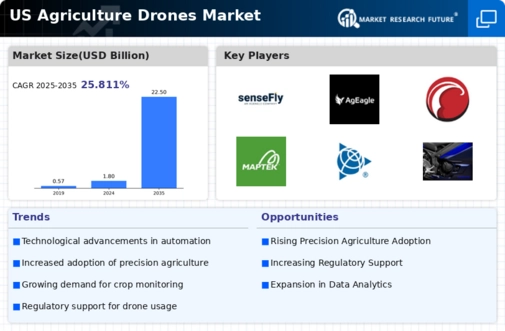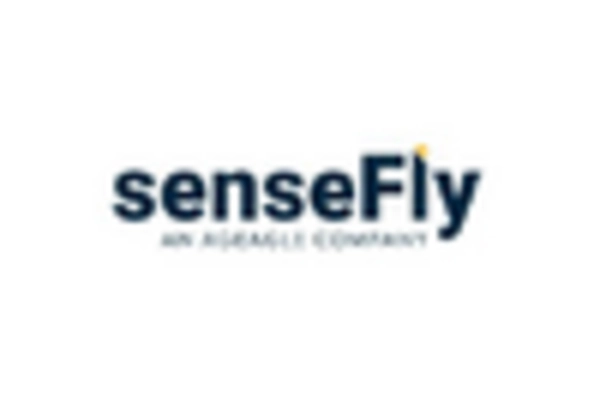Enhanced Crop Yield and Quality
The agriculture drones market is significantly influenced by the need for enhanced crop yield and quality. Drones provide farmers with the tools to monitor crop health and growth patterns, allowing for timely interventions that can lead to improved yields. Studies indicate that the use of drones can increase crop yields by as much as 20% through better management practices. This capability is particularly crucial in a competitive agricultural landscape where quality and quantity are paramount. As farmers strive to meet consumer demands for higher quality produce, the agriculture drones market is likely to see continued growth, driven by the promise of better agricultural outcomes.
Rising Demand for Crop Monitoring
The agriculture drones market is experiencing a notable surge in demand for crop monitoring solutions. Farmers are increasingly recognizing the value of real-time data collection for assessing crop health, soil conditions, and irrigation needs. This trend is driven by the necessity to optimize yields and reduce resource wastage. According to recent estimates, the market for precision agriculture, which includes drone technology, is projected to reach approximately $12 billion by 2026. The ability of drones to provide high-resolution imagery and analytics is transforming traditional farming practices, making them more efficient and data-driven. As a result, the agriculture drones market is likely to expand significantly as more farmers adopt these technologies to enhance productivity and sustainability.
Cost Reduction in Farming Operations
Cost efficiency is a critical driver in the agriculture drones market, as these technologies can significantly reduce operational expenses. Drones facilitate precise application of fertilizers, pesticides, and water, minimizing waste and lowering input costs. By employing drones, farmers can achieve savings of up to 30% on inputs, which is particularly beneficial in an era of fluctuating commodity prices. Furthermore, the automation of tasks such as crop scouting and monitoring allows for labor cost reductions, which can be substantial in large-scale farming operations. This financial incentive is encouraging more farmers to invest in drone technology, thereby propelling the growth of the agriculture drones market.
Environmental Sustainability Initiatives
Environmental sustainability is becoming a pivotal concern in agriculture, driving the growth of the agriculture drones market. Drones enable farmers to implement sustainable practices by optimizing resource use and minimizing environmental impact. For instance, precision application of inputs reduces runoff and pollution, aligning with regulatory frameworks aimed at promoting eco-friendly farming. The agriculture sector is under pressure to adopt practices that mitigate climate change effects, and drone technology offers viable solutions. As more farmers seek to comply with sustainability standards, the agriculture drones market is expected to expand, reflecting a shift towards greener agricultural practices.
Integration with Data Analytics Platforms
The integration of agriculture drones with advanced data analytics platforms is emerging as a significant driver for the agriculture drones market. Drones equipped with sensors and imaging technology collect vast amounts of data, which can be analyzed to derive actionable insights. This capability enhances decision-making processes related to crop management, pest control, and resource allocation. The market for agricultural data analytics is expected to grow at a CAGR of around 15% over the next few years, indicating a strong correlation with the adoption of drone technology. As farmers increasingly rely on data-driven strategies, the agriculture drones market is likely to benefit from this trend, fostering innovation and efficiency in farming practices.

















Leave a Comment